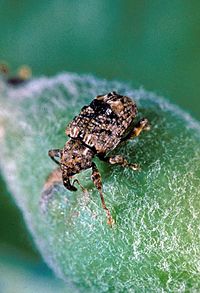Plum curculio
| Plum curculio | |
|---|---|
 |
|
| Scientific classification | |
| Kingdom: | Animalia |
| Phylum: | Arthropoda |
| Class: | Insecta |
| Order: | Coleoptera |
| Family: | Curculionidae |
| Subfamily: | Molytinae |
| Genus: | Conotrachelus |
| Species: | C. nenuphar |
| Binomial name | |
|
Conotrachelus nenuphar (Herbst, 1797) |
|
The plum curculio (Conotrachelus nenuphar) is a true weevil native to the regions east of the Rocky Mountains in the United States and Canada. It is notorious for destroying fruits if left uncontrolled.
A female curculio uses a number of hosts to lay her eggs in, including plums, peaches, apples, pears, and other pome and stone fruits. After the female has chosen a suitable host, she will build an egg chamber under the fruit skin to receive the egg. She then turns around and places the egg in the cavity. Next, she slices a curved slit underneath the egg cavity, leaving the egg in a flap of flesh and causing a crescent-shaped scar on the outside of the fruit. Without this curved slit, eggs are killed by pressure from the growth of the host fruit.
Plum curculio larvae are typically 6 to 9 mm long when fully grown, when they reach the pupal stage measuring about 5 to 7 mm; all adult characteristics are visible in this stage prior to transformation. Adult plum curculio are about 4 to 6 mm long and have a small, rough snout colored with black, gray, and brown specks. Four pairs of ridges cover the wings; however, because of the middle humps they appear to have only two ridges.
The plum curculio can be found in apple, nectarine, plum, cherry, peach, apricot, pear and quince. It may also survive on wild plum, hawthorn, and crabapple. It is found most commonly in areas east of the Rocky Mountains and in eastern Canada. The beetles are most active during the spring time when the weather is warm, damp, and cloudy. They are often seen in heavy leafed trees.
...
Wikipedia
